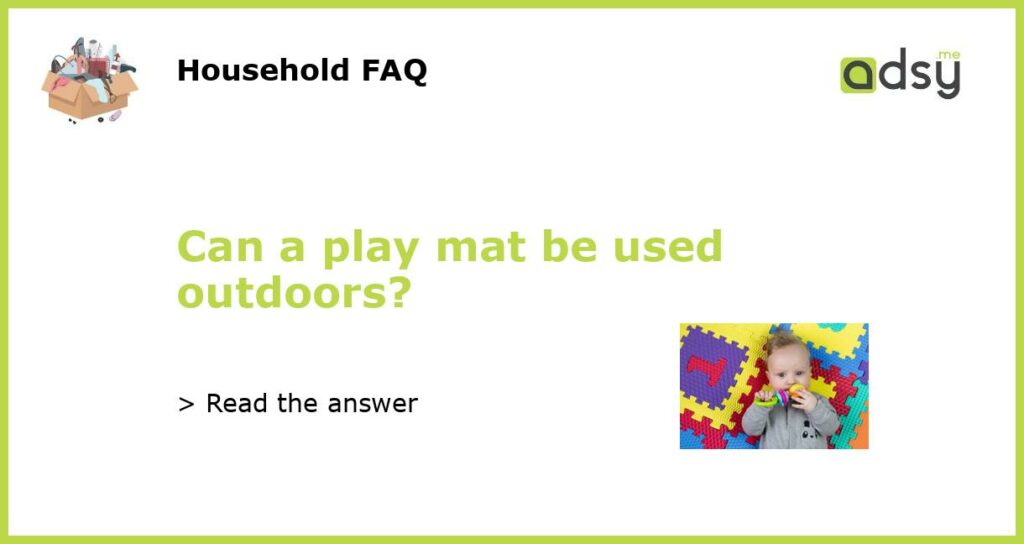Introduction
Yes, a play mat can be used outdoors! While play mats are commonly used indoors to create a safe and comfortable play area for infants and toddlers, they can also be used outdoors to provide a clean and cushioned surface for playtime. Outdoor play mats come in various designs and materials that are specifically designed to withstand outdoor conditions such as sunlight, rain, and dirt. In this article, we will explore the benefits of using a play mat outdoors and provide some tips on how to choose the right play mat for outdoor use.
Benefits of Using a Play Mat Outdoors
Using a play mat outdoors offers several benefits for parents and children alike. Firstly, it provides a soft and comfortable surface for children to play on, protecting them from hard and uneven surfaces. Play mats can help prevent injuries caused by falls and tumbles, making outdoor playtime safer and more enjoyable.
Secondly, outdoor play mats can be easily cleaned, allowing parents to maintain a hygienic play area for their children. Most outdoor play mats are made from materials that can be wiped clean or hosed down, making it easy to remove dirt, mud, and other outdoor messes.
Additionally, outdoor play mats provide a defined play area, which can help children stay within boundaries and reduce the risk of wandering off or getting lost. This can be particularly useful in public parks or other outdoor spaces where there may be potential hazards or distractions.
Finally, using a play mat outdoors can promote sensory play and exploration. Many outdoor play mats feature colorful designs and tactile elements that can stimulate a child’s senses and encourage imaginative play. By providing a designated play space, outdoor play mats can also help children focus on their activities and engage more deeply in their play.
Choosing the Right Play Mat for Outdoor Use
When choosing a play mat for outdoor use, there are a few factors to consider to ensure that it is suitable for the intended environment. Here are some tips to help you make the right choice:
1. Material: Look for play mats made from durable and weather-resistant materials such as PVC or polypropylene. These materials can withstand outdoor conditions without getting damaged or deteriorating quickly. Avoid play mats with fabric surfaces, as they may be more prone to mold and mildew when exposed to moisture.
2. Size and Thickness: Consider the size and thickness of the play mat based on your specific needs. A larger size may be more suitable for open outdoor spaces, while a smaller size may be easier to transport and store. The thickness of the play mat should provide adequate cushioning for falls, but not be too thick that it becomes unstable or difficult to clean.
3. Portability: If you plan on using the play mat in different outdoor locations, look for a lightweight and portable option. Play mats that can be easily rolled up or folded are convenient for transportation and storage.
4. Safety Features: Check for safety features such as non-slip surfaces or non-toxic materials. Non-slip surfaces can prevent accidental slips and falls, while non-toxic materials ensure that the play mat is safe for children to play on.
5. Design: Choose a design that appeals to both you and your child. Outdoor play mats come in various patterns, colors, and themes, so you can select one that suits your aesthetic preferences while also engaging your child’s interest.
Maintenance and Care
To keep your outdoor play mat in good condition, it is important to follow proper maintenance and care practices. Here are some tips to prolong the lifespan of your play mat:
1. Regular Cleaning: Clean your play mat regularly to remove dirt, debris, and any outdoor messes. Use a mild soap or detergent and a soft cloth or sponge to wipe down the surface. Avoid using harsh chemicals or abrasive scrubbing tools, as they can damage the play mat.
2. Drying: After cleaning, ensure that the play mat is completely dry before storing it. Moisture can lead to mold or mildew growth, which can damage the play mat and pose health risks.
3. Storage: Store your outdoor play mat in a clean and dry area when not in use. Avoid exposing it to direct sunlight or extreme temperatures, as this can cause the material to deteriorate over time.
4. Inspections: Regularly inspect your play mat for any signs of damage or wear and tear. Replace any damaged or worn-out parts to maintain the safety and functionality of the play mat.
Conclusion
In conclusion, a play mat can definitely be used outdoors to create a safe and comfortable play area for children. Outdoor play mats offer numerous benefits, including improved safety, easy cleaning, defined play areas, and sensory stimulation. When choosing an outdoor play mat, consider factors such as the material, size, portability, safety features, and design. By following proper maintenance and care practices, you can ensure that your outdoor play mat remains in good condition for extended use. So go ahead, bring the fun outside and let your children enjoy playtime on a versatile and durable outdoor play mat!






